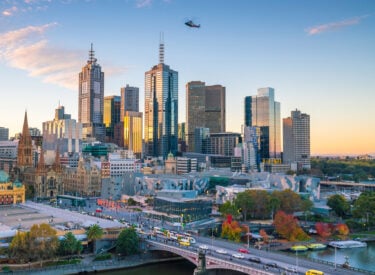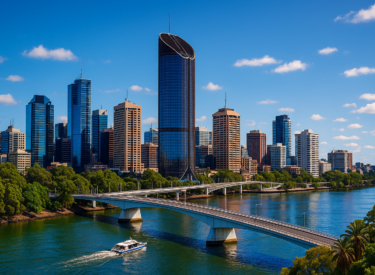
Key takeaways
Do property values really every 10 years? And what can we expect to happen to the value of the property over the next decade?
While the theory of property values doubling every decade is rooted in historical trends, particularly from the 1970s, 80s and 90s when inflation was high and property values grew strongly, it’s too simplistic and doesn’t hold up in today’s more complex market.
What many forget is that markets move in cycles, not straight lines. Prices don’t rise in neat increments year after year.
When it comes to buying an investment property, you want to make sure you’re putting your money into an investment-grade property in a growth suburb.
The focus should be on long-term capital growth, not short-term price fluctuations.
Only 4% of the properties on the market today are what you'd classify as true investment-grade—meaning scarcity adds further value.
Successful investors aim to double their property value every 7–10 years, which is achievable in the right location with the right property.
How long does it take for the price of a well located property to double?
Do property values really every 10 years? And what can we expect to happen to the value of the property over the next decade?
Let me start by saying that the idea that property values double every 7 to 10 years is one of those real estate myths that gets repeated frequently.
And while it’s rooted in historical trends, particularly from the 1970s, 80s and 90s when inflation was high and property values grew strongly, it’s too simplistic and doesn’t hold up in today’s more complex market.
This myth likely stems from the long-term average annual capital growth rate of around 7% (according to the ABS figures going back 40 years), which, when compounded, does indeed lead to doubling in roughly a decade.
But averages are just that - averages.
They gloss over the ups and downs, the booms and busts, the flat periods, and the hot streaks that make up real-life property market cycles.
What many forget is that markets move in cycles, not straight lines. Prices don’t rise in neat increments year after year.
There are periods of rapid growth (like 2021 when interest rates plummeted) followed by plateaus or corrections (as seen in parts of 2022 when interest rates started rising).
So while some properties might double in under a decade during a strong cycle, others might take 15 or even 20 years.
To make sure your property outperforms the averages, when it comes to buying an investment property, you want to make sure you’re putting your money into an investment-grade property in a growth suburb.

Tip: Due diligence is key here, so it’s vital to do your research into location, demand levels, property types, and long-term price trends to make the best investment decision.
Rather than looking at short-term growth, it’s important to look at the average house price growth over at least 10 years as this gives a great indicator of what to expect from your investment property in the next 10 years or so.
On the other hand, looking at the performance of a location or a particular property over a shorter period can be deceptive.


Note: Before we explore how each capital city has performed over the last decade it is worth noting that the period since 2020 has been unusual.
We had an initial COVID-driven surge with a once in a generation property, because interest rates plummeted , then this was followed by interest rate hikes that significantly cooled the market.
Around Australia the pace of growth was uneven, driven by local economic growth, supply constraints, regional demand, and affordability.
Some cities, like Perth, Brisbane and Adelaide, saw stronger growth thanks to interstate migration and affordability, while Melbourne properties languished due to local economic challenges.
If inflation remains under control for the rest of the decade, I see property values continuing to rise but more slowly, and it may take longer than 10 years for prices to double.
That said, Australia’s chronic property undersupply, strong population growth, and ongoing urbanisation trends suggest we’ll still see values double in many areas—just not uniformly, and not always in 10 years.
Sydney house price growth over the last 10 years
Looking at Sydney’s house price growth over the last 10 years, values in Australia’s harbour city have doubled.
As you can see in the chart below, Sydney’s house price growth has steadily increased over the entire 14-year period listed in SQM’s research, with the exception of a minor dip in values around 2019 and again when interest rates started rising in 2022
Overall, Sydney’s median house price has grown an impressive 97% over the past 10 years.
The majority of Sydney’s property price growth occurred during the initial 2021-2022 pandemic-induced property boom, with levels rising again through late 2023 and into this year.
Sydney's asking property prices
| Property type | Median price | 12-month change | 3 year (pa) change | 7 year (pa) change | 10 year (pa) change |
|---|---|---|---|---|---|
| All houses | $2,038,727 | 5.9% | 5.3% | 6.0% | 6.6% |
| 3-br houses | $1,753,274 | 5.8% | 4.2% | 5.1% | 5.8% |
| All units | $854,431 | 6.8% | 6.1% | 2.3% | 3.4% |
| 2-br units | $898,035 | 4.0% | 5.5% | 2.5% | 3.4% |
| Combined | $1,557,155 | 5.8% | 5.1% | 4.9% | 5.7% |
Source: SQM Research, May 2025
Melbourne house price growth over the last 10 years
Similarly, looking at Melbourne’s house price growth over the last 10 years, values in Australia’s southern city have also doubled.
Unlike Sydney, the data shows that while the Melbourne property market has enjoyed a consistent rise in property values, it has not grown as strongly over the last couple of years in part related to the challenges with the local economy.
Having said that, over the 10-year period, Melbourne’s house prices have grown 96.15%.
However Melbourne apartments values have floundered over the last decade, meaning anyone buying an established apartment in Melbourne at present would be able to purchase it at below replacement cost, meaning there is considerable inbuilt intrinsic value.
Melbourne's asking property prices
| Property type | Median price | 12 month change | 3 year (pa) change | 7 year (pa) change | 10 year (pa) change |
|---|---|---|---|---|---|
| All Houses | $1,278,290 | 1.8% | 2.6% | 3.5% | 6.9% |
| 3-br Houses | $1,147,243 | 1.8% | 2.0% | 2.7% | 5.8% |
| All Units | $628,365 | 3.5% | 2.3% | 2.2% | 3.9% |
| 2-br Units | $604,020 | 1.4% | 1.1% | 1.4% | 2.9% |
| Combined | $1,073,175 | 1.9% | 2.3% | 3.0% | 6.1% |
Source: SQM Research, May 2025
Brisbane house price growth over the last 10 years
It’s much the same for Brisbane’s house price growth over the last 10 years, as values in Queensland’s largest city have also doubled.
As you can see in the chart below, the majority of Brisbane’s house price growth occurred during the 2021 pandemic property market boom, with prices surging again from late 2023 through to today.
Brisbane's asking property prices
| Property type | Median price | 12 month change | 3 year (pa) change | 7 year (pa) change | 10 year (pa) change |
|---|---|---|---|---|---|
| All Houses | $1,232,304 | 12.5% | 10.5% | 10.5% | 8.4% |
| 3-br Houses | $1,013,013 | 10.4% | 8.0% | 9.7% | 7.6% |
| All Units | $714,923 | 17.8% | 17.0% | 9.4% | 6.7% |
| 2-br Units | $680,606 | 13.5% | 16.4% | 9.2% | 6.5% |
| Combined | $1,102,374 | 13.2% | 11.3% | 10.2% | 8.1% |
Source: SQM Research, May 2025
Adelaide house price growth over the last 10 years
Values in the South Australian capital have grown strongly over the last 10 years.
As you can see by the chart below, the majority of that increase has occurred since the pandemic boom when an otherwise very stable property market skyrocketed in line with a nationwide property surge.
Unlike values in Sydney, Melbourne, or Brisbane, Adelaide’s property prices then continued to rise sharply through 2023 and into 2024.
Adelaide's asking property prices
| Property type | Median price | 12 month change | 3 year (pa) change | 7 year (pa) change | 10 year (pa) change |
|---|---|---|---|---|---|
| All Houses | $1,010,891 | 11.6% | 12.7% | 10.3% | 7.6% |
| 3 br Houses | $925,047 | 12.8% | 11.5% | 9.9% | 7.4% |
| All Units | $538,904 | 16.5% | 16.4% | 8.5% | 6.2% |
| 2 br Units | $533,662 | 12.2% | 15.2% | 9.2% | 6.5% |
| Combined | $926,024 | 12.1% | 13.1% | 10.0% | 7.4% |
Source: SQM Research, May 2025
Perth house price growth over the last 10 years
Looking at Perth’s house price growth over the last 10 years, values in Western Australia's capital have generally experienced very low levels of growth.
As you can see on the chart below, Perth’s property prices saw a small but gradual decline between 2014 and the 2021 pandemic boom, before upticking in line with the rest of the country over the last 17 months.
The strongest uptick has occurred in the first two months of 2024.
Perth’s asking property prices
| Property type | Median price | 12 month change | 3 year (pa) change | 7 year (pa) change | 10 year (pa) change |
|---|---|---|---|---|---|
| All Houses | $1,125,006 | 14.2% | 14.6% | 7.4% | 4.3% |
| 3-br Houses | $994,016 | 14.0% | 13.1% | 7.4% | 4.2% |
| All Units | $649,670 | 26.5% | 17.2% | 7.2% | 3.7% |
| 2-br Units | $615,105 | 22.2% | 15.6% | 6.8% | 3.6% |
| Combined | $1,000,524 | 16.0% | 14.9% | 7.3% | 4.1% |
Source: SQM Research, May 2025
Which Australian city has the best result?
The data differs for each of Australia’s 5 major capitals, but there is a clear trend throughout… growth.
The data shows that in Sydney, Melbourne, Brisbane, and Adelaide, house prices have increased by an impressive 80-100%.
Perth has enjoyed a lower but relatively stable 4.3%.
House prices over the last 10 years in each major Australian city
| City | Median house price | Growth per annum | Total 10-year growth |
|---|---|---|---|
| Sydney | $2,038,727 | 5.9% | 6.6% |
| Melbourne | $1,278,290 | 1.8% | 6.9% |
| Brisbane | $1,232,304 | 12.5% | 8.4% |
| Adelaide | $1,010,891 | 11.6% | 7.6% |
| Perth | $1,125,006 | 14.2% | 4.3% |
Source: SQM Research, May 2025
While the figures for house price growth over the past 10 years are impressive, history shows that some areas and properties outperform others in terms of capital growth by an additional 50-100%.
In other words, strategic property investors can outperform the averages.
And there is no reason why those property investors who buy an investment-grade property today should not see their property’s value double within the next 7 to 10 years.
In the medium term, our property markets will be underpinned by 3 factors:
- A significantly growing population
- Strong jobs creation
- Increasing the wealth of our nation

Note: The problem is...in my mind only around 4% of the properties on the market currently are what I would call "investment-grade".
It’s also worthwhile noting that you can’t just look at a city or state-wide level.
Because not only does each city have its own property cycle - but there are also cycles within each cycle.
However, I see the current market offering a window of opportunity for property investors with a long-term focus.
You see…we are at the early stages of a new property cycle, something that doesn’t happen very often.
Not that I suggest you try and time the market- this is just too difficult, and in truth, you’ve missed the bottom which occurred in early 2023.
But if the market hands you an opportunity like this, why not take advantage of it?
Taking advantage of the upturn stage of a new property has created significant wealth for investors in the past.
Moving forward, demand is going to outstrip supply for some time to come as we experience record levels of immigration at a time when we’re not building anywhere as many properties as we require.
At the same time, the cost of construction of delivering new dwellings will keep increasing not only because of supply chain issues and the lack of sufficient skilled labour but also because builders and developers will only commence new projects if they are financially viable and currently new projects will need to come on line at considerably higher prices than the current market price.
In due course, consumer sentiment will rebound when it becomes clear that inflation continues to fall and interest rates keep falling.
At that time pent-up demand will be released as greed (FOMO) overtakes fear (FOBE - Fear of buying early), as it always does as the property cycle moves on.
We are also going to be experiencing a prolonged period of strong rental growth - the rental crisis will only worsen further, with no end in sight.
Now I'm not suggesting taking advantage of tenants, what I'm suggesting is to recognise there is currently a problem (lack of rental accommodation) and provide a solution.
So rather than trying to hunt down a bargain, focus on buying an investment-grade property in an A-grade location because these types of properties are in short supply but are still selling for reasonably good prices…
Plus they’ll hold their value far better in the long term.
READ MORE: Do property values really double every 7 to 10 years?














